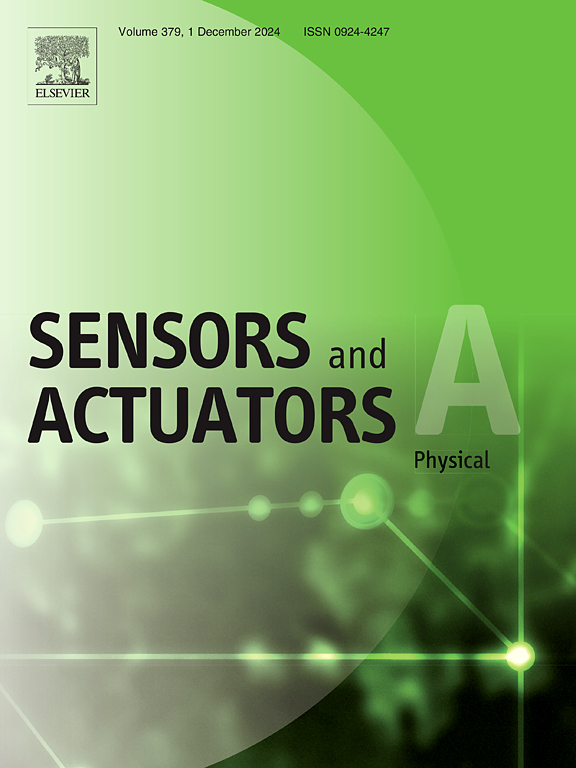基于RIME-VMD和PSO-DBN多融合算法的MEMS多环盘式固体波陀螺仪温度补偿模型
IF 4.9
3区 工程技术
Q2 ENGINEERING, ELECTRICAL & ELECTRONIC
引用次数: 0
摘要
为了解决MEMS陀螺仪中温度引起的输出漂移过大的问题,提出了一种基于RIME-VMD-PSO-DBN多重融合算法的零偏置温度补偿模型。该模型利用RIME对VMD算法中的输入参数进行优化,并利用RIME-VMD对MEMS多环盘式固波陀螺仪的温度漂移进行分解。将温度漂移信号分解为多个本征模态函数(IMFs),并根据频率进行分类和处理。采用PSO-DBN和CWT分别对高频噪声项、中频混合噪声项和温度特征项进行处理。最后,对处理后的信号进行ELM重构。实验结果表明,在−40 ℃~ 60 ℃条件下,零偏不稳定性从78.48°/h减小到0.81°/h,角度随机游走从36.2°/h减小到0.15°/h。在60℃~ 40℃条件下,零偏不稳定性从49.32°/h降至0.98°/h,角度随机游走从47.53°/h降至0.42°/h。本文章由计算机程序翻译,如有差异,请以英文原文为准。
Temperature compensation model of MEMS multi-ring disk solid wave gyroscope based on RIME-VMD and PSO-DBN multi fusion algorithm
In order to address the problem of temperature-induced excessive output drift in MEMS gyroscopes, a zero-bias temperature compensation model based on RIME-VMD-PSO-DBN multiple fusion algorithm is developed in this study. The model utilizes RIME to optimize the input parameters in the VMD algorithm and decomposes the temperature drift of MEMS multi-ring disk solid wave gyroscope through RIME-VMD. The temperature drift signal is decomposed into multiple intrinsic mode functions (IMFs), and is classified and processed according to the frequency. The high-frequency noise term, intermediate frequency mixed noise term, and temperature feature term are processed by PSO-DBN and CWT, respectively. Finally, the processed signal is reconstructed by ELM. Experimental results show that under the conditions of −40 ℃ ∼ 60 ℃, the zero bias instability decreases from 78.48°/h to 0.81 °/h, and the angle random walk reduces from 36.2 to 0.15. Under the conditions of 60 ℃ −40 ℃, the zero bias instability declines from 49.32 °/h to 0.98 °/h, and the angle random walk reduces from 47.53to 0.42.
求助全文
通过发布文献求助,成功后即可免费获取论文全文。
去求助
来源期刊

Sensors and Actuators A-physical
工程技术-工程:电子与电气
CiteScore
8.10
自引率
6.50%
发文量
630
审稿时长
49 days
期刊介绍:
Sensors and Actuators A: Physical brings together multidisciplinary interests in one journal entirely devoted to disseminating information on all aspects of research and development of solid-state devices for transducing physical signals. Sensors and Actuators A: Physical regularly publishes original papers, letters to the Editors and from time to time invited review articles within the following device areas:
• Fundamentals and Physics, such as: classification of effects, physical effects, measurement theory, modelling of sensors, measurement standards, measurement errors, units and constants, time and frequency measurement. Modeling papers should bring new modeling techniques to the field and be supported by experimental results.
• Materials and their Processing, such as: piezoelectric materials, polymers, metal oxides, III-V and II-VI semiconductors, thick and thin films, optical glass fibres, amorphous, polycrystalline and monocrystalline silicon.
• Optoelectronic sensors, such as: photovoltaic diodes, photoconductors, photodiodes, phototransistors, positron-sensitive photodetectors, optoisolators, photodiode arrays, charge-coupled devices, light-emitting diodes, injection lasers and liquid-crystal displays.
• Mechanical sensors, such as: metallic, thin-film and semiconductor strain gauges, diffused silicon pressure sensors, silicon accelerometers, solid-state displacement transducers, piezo junction devices, piezoelectric field-effect transducers (PiFETs), tunnel-diode strain sensors, surface acoustic wave devices, silicon micromechanical switches, solid-state flow meters and electronic flow controllers.
Etc...
 求助内容:
求助内容: 应助结果提醒方式:
应助结果提醒方式:


